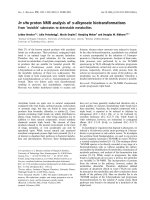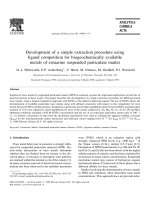Analysis of a simple sentence
Bạn đang xem bản rút gọn của tài liệu. Xem và tải ngay bản đầy đủ của tài liệu tại đây (8.26 KB, 1 trang )
Analysis of a simple sentence
A
simple sentence
consists of just one clause.
To analyze a simple sentence, we must first of all learn how to divide the sentence into two main parts – the
subject and the predicate.
Study the examples given below.
Birds chirp. (Subject – birds; predicate – chirp)
The boy sang a song. (Subject – the boy; predicate – sang a song)
She was ironing the clothes. (Subject – she; predicate – was ironing the clothes)
The
subject
is the person or thing that performs the action denoted by the verb. The subject is a noun or a
pronoun. It can also be an –ing form or a to-infinitive.
The subject may be qualified by an article, an adjective or another word/phrase that acts as an adjective.
This word or phrase that modifies the subject is called the
enlargement or attribute of the subject.
Study the example given below.
My little daughter loves to play with her dolls.
Here the subject daughter is modified by the possessive ‘my’ and the adjective ‘little’.
The
predicate
consists of the verb, the object and other parts of the sentence except the subject.
In the above example, the predicate is: loves to play with her dolls
The
predicate
may consist of one word or several words. When the predicate consists of just one word, it is the
verb. When it consists of more than one word, it may contain one or more adverbs and/or one or more objects.
When the verb is a form of
‘be’
, the sentence will require a word/phrase to make its meaning complete.
This word or phrase that completes the verb and makes the sentence meaningful is called
the complement.
Be first to know when grammar rules change! Sign up to our newsletter here: englishgrammar.org (It's free)
Powered by TCPDF (www.tcpdf.org)









